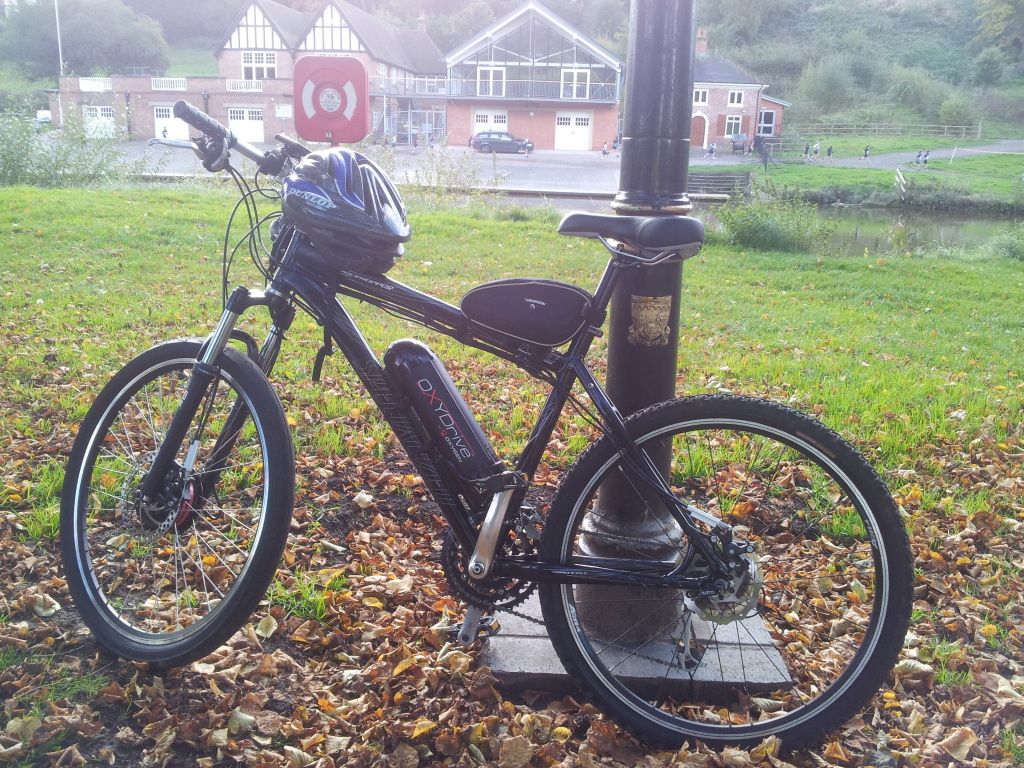the bike I am fitting to is MTB GIANT BOULDER link can be found in this thread it is a bottle shape and have measured up and seems ok. The spec is:
Specification:
1.Model: 36V12AH tube type(Polymer lithium ion cells)
2. Voltage : 36V
3. Capacity: 12Ah 0.5C Discharge
4. Max Charging voltage: 42V
5. Discharging cut-off voltage : 30.0V
6. Max charging current :2A
7. Continue discharging current :15A
8. Peak current: 30A
9. Lifespan : 600 Cycles >capacity 60% 0.5C
10. Available capacity : >96% (30.0V cut off)
11. Weight (Approx) :3.2KG
12. Dimension: 92*370mm
13. Charging temperature: -10°C to 55°C
14. Discharging temperature: 0°C to 45°C
15. Storage temperature: 10°C to 30°C
Characteristics:
NO. Item Requirements Test Method
1 Discharge
Characteristics Discharge capacity
Nominal capacity×100%
A)0.2C5A ≥100%
B)0.5C5A ≥98%
C)1C5A ≥95%
Standard charge at 0.2C5A under the condition of normal atmospheric pressure and the environmental temperature of 25°C±5°C and 45%~80% RH(unless otherwise specified, storage and charging should be conducted as this regime), then rest for 10min and discharge at 0.2C5A,0.5C5A,1C5A to 30V respectively. Charge/discharge cycle can be conducted for 3 times before meeting the Standards(the same below).
2 Normal Storage Residual Capacity≥Nominal capacity*85%
Recoverable capacity≥Nominal capacity *90%
OCV decrease≤3%
impendance increase ≤20% Measure initial status and initial capacity. Store for 28 days after standard charge, then measure final status and residual capacity at 0.2C5A to 30.0V; After charge/discharge(1C/0.5C) cycle can be conducted for 3 times , measure the recoverable capacity before meeting the Standards(the same below).
3 Cycle Life Discharge Capacity≥Nominal apacity*60% 0.5C discharger
Measure initial status and initial capacity, then conduct 0.5C discharge cycle for 600 times . Measure last status and last capacity 60%
Safety Performance:
NO. Item Requirements Test Method
1 Over charge No fire,no explosion After standard charging,then Charge at 3C5A to 10.0V
2 Over discharge No fire,no explosion
After standard charging,discharge 0.3C5A to 0V
at 20°C±5°C
3 Drop
No fire,no explosion
no leakage
After standard charging, then let it self fall off from
a height of 1.5m(the lowest height)to a rigid wooden
board with the thickness of 20mm. The drop is
implemented one time for every face.
4 Hot Oven No fire,no explosion
After standard charging. Keep the battery in the box
with constant temperature of 85°C±2 °C and
remained for 2hours at this temperature.
5 Crush No fire,no explosion
After standard charging, keep the battery
on the bracket
1. Extrusion direction

erpendicular to the direction
of maintaining pressure on the battery plates.
2. Extrusion headdress product:≥20cm
3. Extrusion degree: Until the battery shell ruptured
or internal short circuit (battery voltage becomes 0V)
6 Needle
puncture
performance No fire,no explosion
After standard charging, keep the battery on the
bracket,penetrate through it with a 3mm~8mm
diameter nail near the center of its biggest surface
at the rate of 10mm/s-40mm/s.
Charger Specification:
AC Voltage: 110~240V
DC Voltage: 43.8V
DC Current: 2Amps
Dimensions: 51*93*160mm
Net weight: 0.9kg
Features:
1. Short-circuit protection; Charger O/P cut-off automatically when short circuit.
2. Overload protection: Charger O/P current-limited automatically when overload.
3. Reverse polarity protection: Charger O/P cut-off automatically when battery reverse connection.
4. Automatic multi-rate charging function: CC,CV,Cut-off .
5. Parallel operation available: Parallel with battery as DC power supply operation available.
2 LED Display: LED1 Red(power on); LED2 Red(charging); Green(full).
So what do you think ? any other forum members have any views on this project ?





